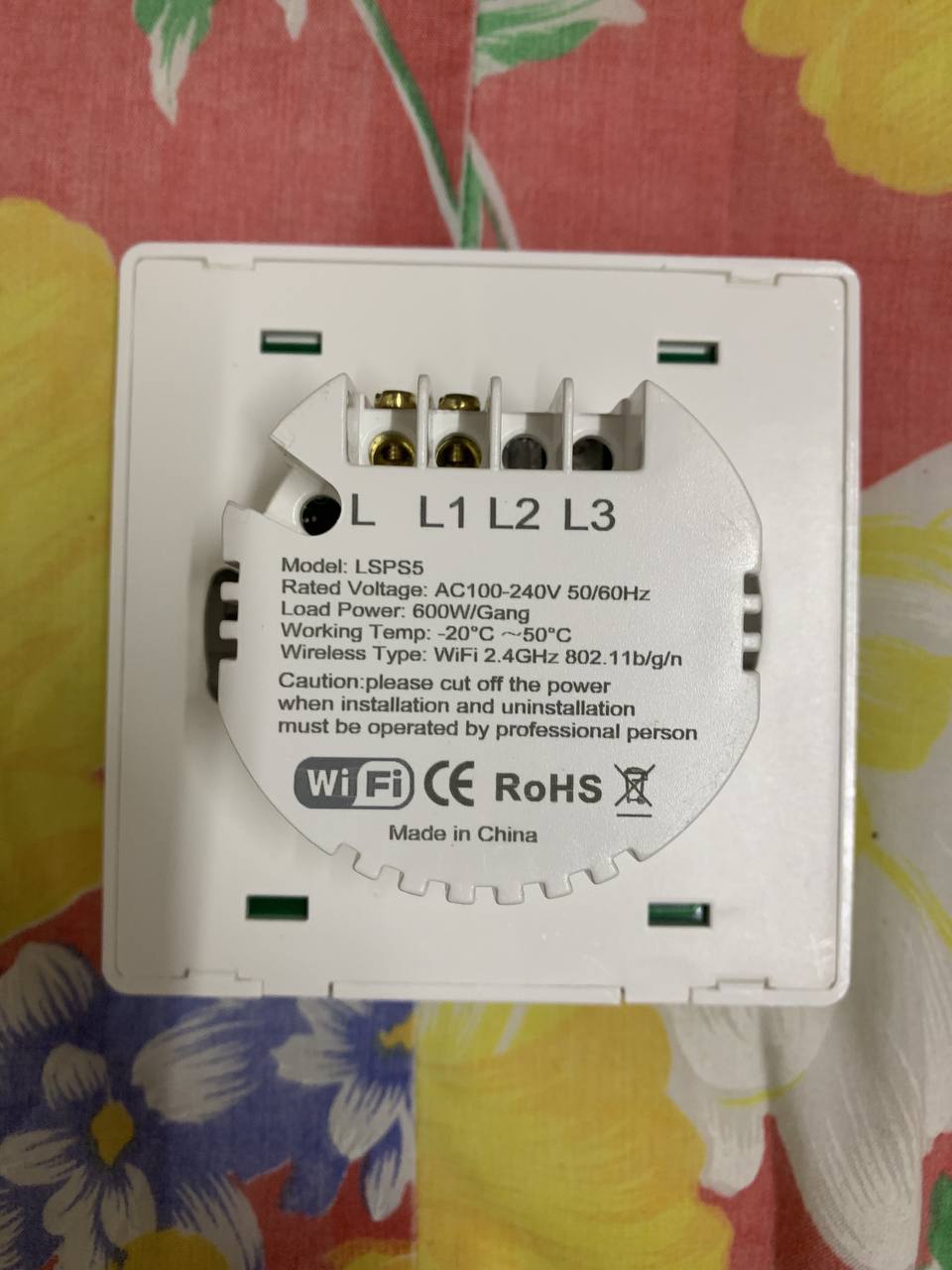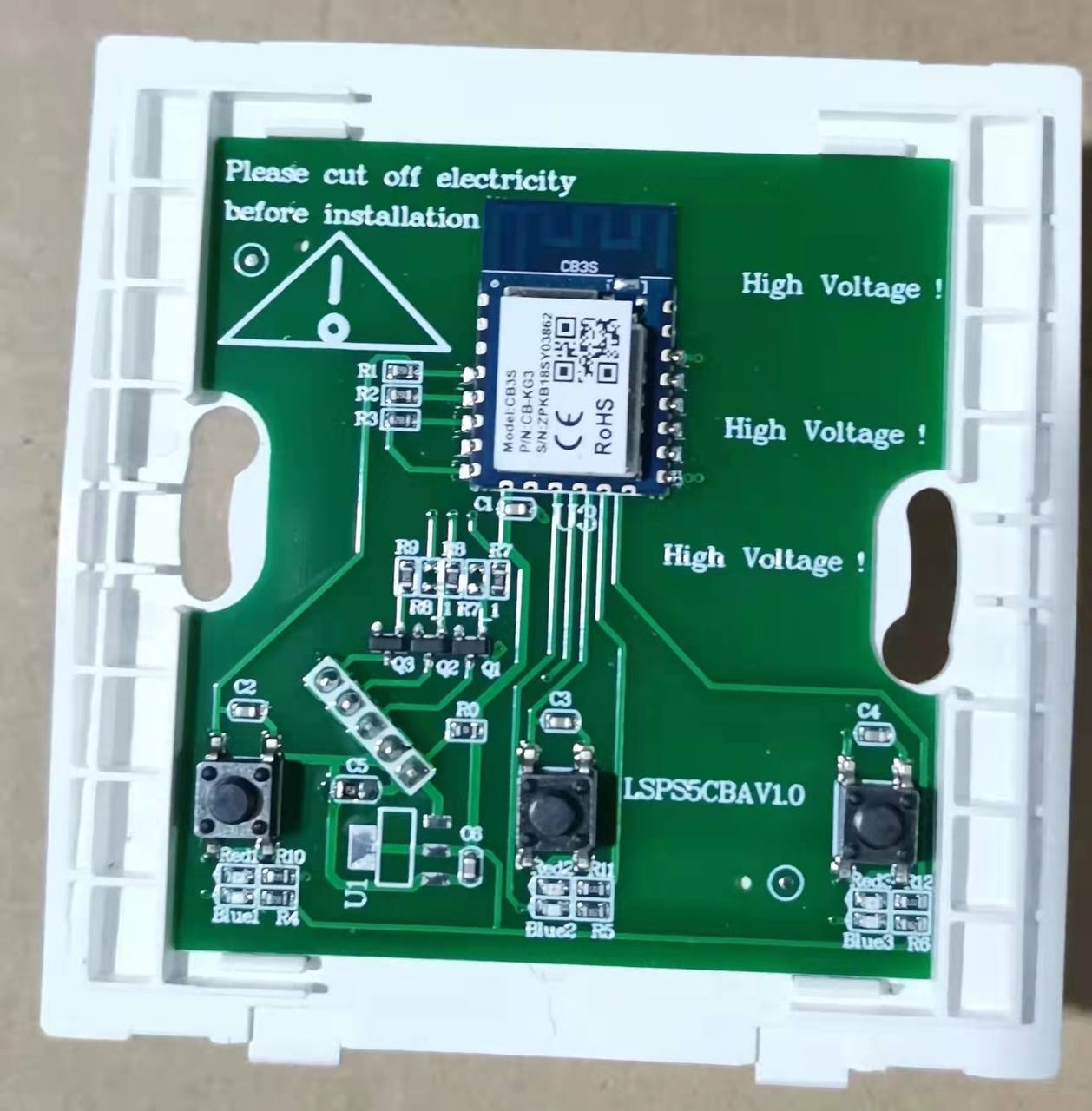LSPS5 Tuya Switch 1-2-3 Gang No Neutral


- Has a BK7231N chip.
- Push button wall switch
- Can be cloudcut using tuya-cloudcutter
GPIO Pinout
1-Gang Version
| Pin | Function |
|---|---|
| GPIO26 | Button 1 |
| GPIO7 | Relay 1 |
| GPIO8 | Relay 1 |
| GPIO6 | Wifi LED indicator |
2-Gang Version
| Pin | Function |
|---|---|
| GPIO14 | Button 1 |
| GPIO24 | Button 2 |
| GPIO7 | Relay 1 |
| GPIO9 | Relay 2 |
| GPIO6 | Wifi LED indicator |
3-Gang Version
| Pin | Function |
|---|---|
| GPIO14 | Button 1 |
| GPIO26 | Button 2 |
| GPIO24 | Button 3 |
| GPIO7 | Relay 1 |
| GPIO8 | Relay 2 |
| GPIO9 | Relay 3 |
| GPIO6 | Wifi LED indicator |
PCB

Basic Configuration (1 gang)
substitutions:
devicename: 1gang-switch
friendlyname: 1gang-switch
esphome:
name: $devicename
friendly_name: $friendlyname
bk72xx:
board: generic-bk7231n-qfn32-tuya
framework:
version: latest
# Enable logging
logger:
# Enable Home Assistant API
api:
ota:
- platform: esphome
wifi:
ssid: !secret wifi_ssid
password: !secret wifi_password
# Enable fallback hotspot (captive portal) in case wifi connection fails
ap:
ssid: "1G-Beken Fallback Hotspot"
password: !secret ap_password
captive_portal:
web_server:
port: 80
sensor:
- platform: uptime
name: $friendlyname Uptime
update_interval: 60s
switch:
- platform: gpio
name: $devicename Switch 1
pin: GPIO8
id: relay_1
binary_sensor:
- platform: status
name: $devicename Status
- platform: gpio
pin:
number: GPIO26
mode: INPUT_PULLUP
inverted: True
name: $devicename Button 1
on_press:
- switch.toggle: relay_1
status_led:
pin:
number: GPIO6
inverted: False
Basic Configuration (2 gang)
substitutions:
devicename: 2gang-switch
friendlyname: 2gang-switch
esphome:
name: $devicename
friendly_name: $friendlyname
bk72xx:
board: generic-bk7231n-qfn32-tuya
framework:
version: latest
# Enable logging
logger:
# Enable Home Assistant API
api:
ota:
- platform: esphome
wifi:
ssid: !secret wifi_ssid
password: !secret wifi_password
# Enable fallback hotspot (captive portal) in case wifi connection fails
ap:
ssid: "2G-Beken Fallback Hotspot"
password: !secret ap_password
captive_portal:
web_server:
port: 80
sensor:
- platform: uptime
name: $friendlyname Uptime
update_interval: 60s
switch:
- platform: gpio
name: $devicename Switch 1
pin: GPIO7
id: relay_1
- platform: gpio
name: $devicename Switch 2
pin: GPIO9
id: relay_2
binary_sensor:
- platform: status
name: $devicename Status
- platform: gpio
pin:
number: GPIO14
mode: INPUT_PULLUP
inverted: True
name: $devicename Button 1
on_press:
- switch.toggle: relay_1
- platform: gpio
pin:
number: GPIO24
mode: INPUT_PULLUP
inverted: True
name: $devicename Button 2
on_press:
- switch.toggle: relay_2
status_led:
pin:
number: GPIO6
inverted: False
Basic Configuration (3 gang)
substitutions:
devicename: 3gang-switch
friendlyname: 3gang-switch
esphome:
name: $devicename
friendly_name: $friendlyname
bk72xx:
board: generic-bk7231n-qfn32-tuya
framework:
version: latest
# Enable logging
logger:
# Enable Home Assistant API
api:
ota:
- platform: esphome
wifi:
ssid: !secret wifi_ssid
password: !secret wifi_password
# Enable fallback hotspot (captive portal) in case wifi connection fails
ap:
ssid: "3G-Beken Fallback Hotspot"
password: !secret ap_password
captive_portal:
web_server:
port: 80
sensor:
- platform: uptime
name: $friendlyname Uptime
update_interval: 60s
switch:
- platform: gpio
name: $devicename Switch 1
pin: GPIO7
id: relay_1
- platform: gpio
name: $devicename Switch 2
pin: GPIO8
id: relay_2
# restore_mode: ALWAYS_ON
- platform: gpio
name: $devicename Switch 3
pin: GPIO9
id: relay_3
binary_sensor:
- platform: status
name: $devicename Status
- platform: gpio
pin:
number: GPIO14
mode: INPUT_PULLUP
inverted: True
name: $devicename Button 1
on_press:
- switch.toggle: relay_1
- platform: gpio
pin:
number: GPIO26
mode: INPUT_PULLUP
inverted: True
name: $devicename Button 2
on_press:
- switch.toggle: relay_2
- platform: gpio
pin:
number: GPIO24
mode: INPUT_PULLUP
inverted: True
name: $devicename Button 3
on_press:
- switch.toggle: relay_3
status_led:
pin:
number: GPIO6
inverted: False
Decoupled mode & toggle/dimming lights using device group
Add this configuration below
For lights
external_components:
- source: github://cossid/tasmotadevicegroupsforesphome@main
components: [device_groups]
refresh: 10 min
device_groups:
- group_name: "cornerlights" # Tasmota device group name
lights:
- light_treatlife_corner
light:
- platform: rgbww
name: $devicename
id: "light_treatlife_corner" #use the same id for device_groups
red: output_red
green: output_green
blue: output_blue
warm_white: output_warmwhite
cold_white: output_coldwhite
color_interlock: true
cold_white_color_temperature: 6500 K
warm_white_color_temperature: 2700 K
default_transition_length: 0.5s
restore_mode: RESTORE_DEFAULT_ON
For switch
Example using button 2 to control lights in the same device group
substitutions:
devicename: 3gang-switch
friendlyname: 3gang-switch
esphome:
name: $devicename
friendly_name: $friendlyname
bk72xx:
board: generic-bk7231n-qfn32-tuya
framework:
version: latest
# Enable logging
logger:
# Enable Home Assistant API
api:
ota:
- platform: esphome
wifi:
ssid: !secret wifi_ssid
password: !secret wifi_password
# Enable fallback hotspot (captive portal) in case wifi connection fails
ap:
ssid: "3G-Beken Fallback Hotspot"
password: !secret ap_password
captive_portal:
web_server:
port: 80
globals:
- id: counter
type: int
restore_value: False
initial_value: "0"
- id: bool_dim_or_bright #false = dim, true = brighten
type: bool
restore_value: no
initial_value: "false"
sensor:
- platform: uptime
name: $friendlyname Uptime
update_interval: 60s
external_components:
- source: github://cossid/tasmotadevicegroupsforesphome@main
components: [device_groups]
refresh: 10 min
device_groups:
- group_name: "cornerlights" # Tasmota device group name
lights:
- internal_light
output:
- platform: template
id: dummy_output
type: float
write_action:
- lambda: return;
light:
- platform: rgbww
id: internal_light
color_interlock: true
cold_white_color_temperature: 6500 K
warm_white_color_temperature: 2700 K
red: dummy_output
green: dummy_output
blue: dummy_output
cold_white: dummy_output
warm_white: dummy_output
switch:
- platform: gpio
name: $devicename Switch 1
pin: GPIO7
id: relay_1
- platform: gpio
name: $devicename Switch 2
pin: GPIO8
id: relay_2
restore_mode: ALWAYS_ON
- platform: gpio
name: $devicename Switch 3
pin: GPIO9
id: relay_3
binary_sensor:
- platform: status
name: $devicename Status
- platform: gpio
pin:
number: GPIO14
mode: INPUT_PULLUP
inverted: True
name: $devicename Button 1
on_press:
- switch.toggle: relay_1
- platform: gpio
pin:
number: GPIO26
mode: INPUT_PULLUP
inverted: True
name: $devicename Button 2
id: button2
on_multi_click:
# single click
- timing:
- ON for at most 1s
- OFF for at least 0.5s
then:
- if:
condition:
and:
- wifi.connected:
# toggle light when wifi is conncected
then:
- light.toggle: internal_light
# toggle relay in case wifi is not connected
else:
- switch.toggle: relay_2
# double click to switch to cold or warm light
- timing:
- ON for at most 1s
- OFF for at most 1s
- ON for at most 1s
- OFF for at least 0.2s
then:
- lambda: |-
auto call = id(internal_light).turn_on();
if (id(counter) == 0) { //Cold white with 100% brightness
call.set_cold_white(1.0);
call.set_brightness(1.0);
}
if (id(counter) == 1) { //Warm white with 50% brightness
call.set_cold_white(0.0);
call.set_warm_white(1.0);
call.set_brightness(0.5);
}
if (id(counter) < 1) { //Or your maximum effects
id(counter) += 1;
} else {
id(counter) = 0;
}
call.perform();
#long press for dimming
on_press:
then:
- if:
condition:
lambda: |-
return id(bool_dim_or_bright);
# When above condition evaluates to true - brighter function else dimmer
then:
- delay: 0.5s
- while:
condition:
binary_sensor.is_on: button2
then:
- light.dim_relative:
id: internal_light
relative_brightness: 5%
transition_length: 0.1s
- delay: 0.1s
- lambda: |-
id(bool_dim_or_bright) = (false);
else:
- delay: 0.5s
- while:
condition:
and:
- binary_sensor.is_on: button2
then:
- light.dim_relative:
id: internal_light
relative_brightness: -5%
transition_length: 0.1s
- delay: 0.1s
- lambda: |-
id(bool_dim_or_bright) = (true);
- platform: gpio
pin:
number: GPIO24
mode: INPUT_PULLUP
inverted: True
name: $devicename Button 3
on_press:
- switch.toggle: relay_3
status_led:
pin:
number: GPIO6
inverted: False